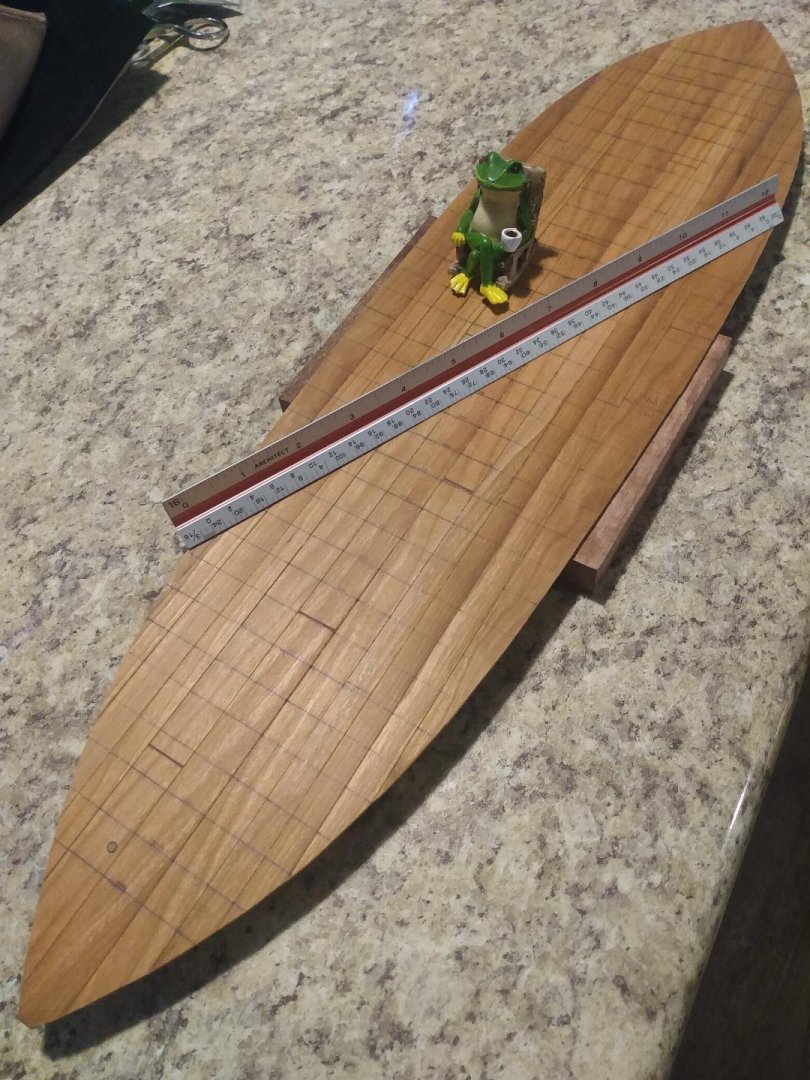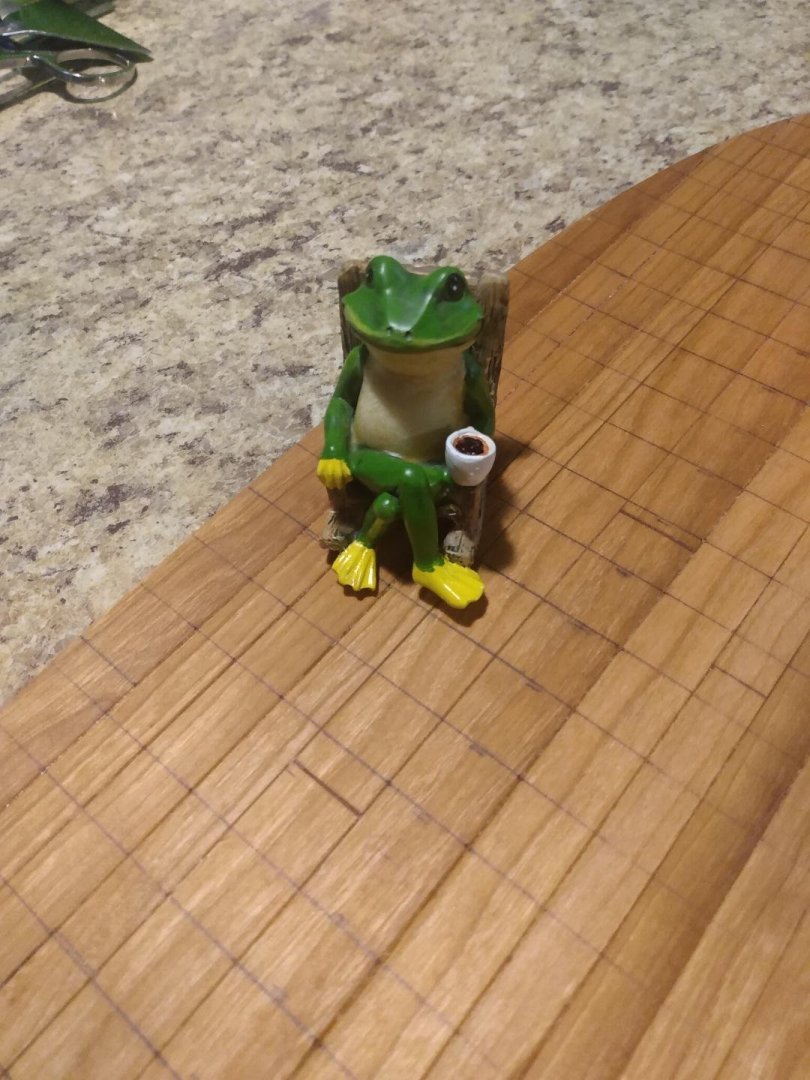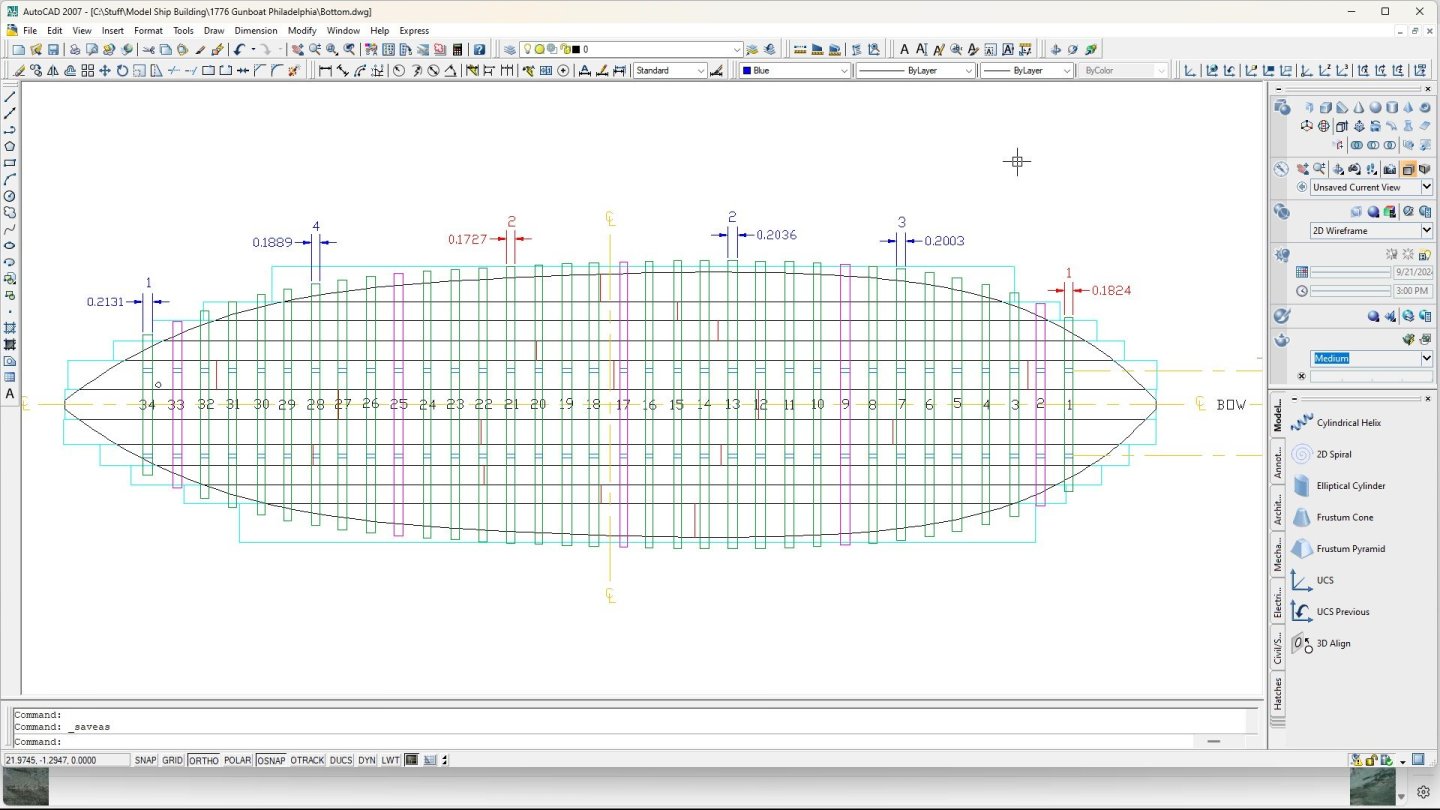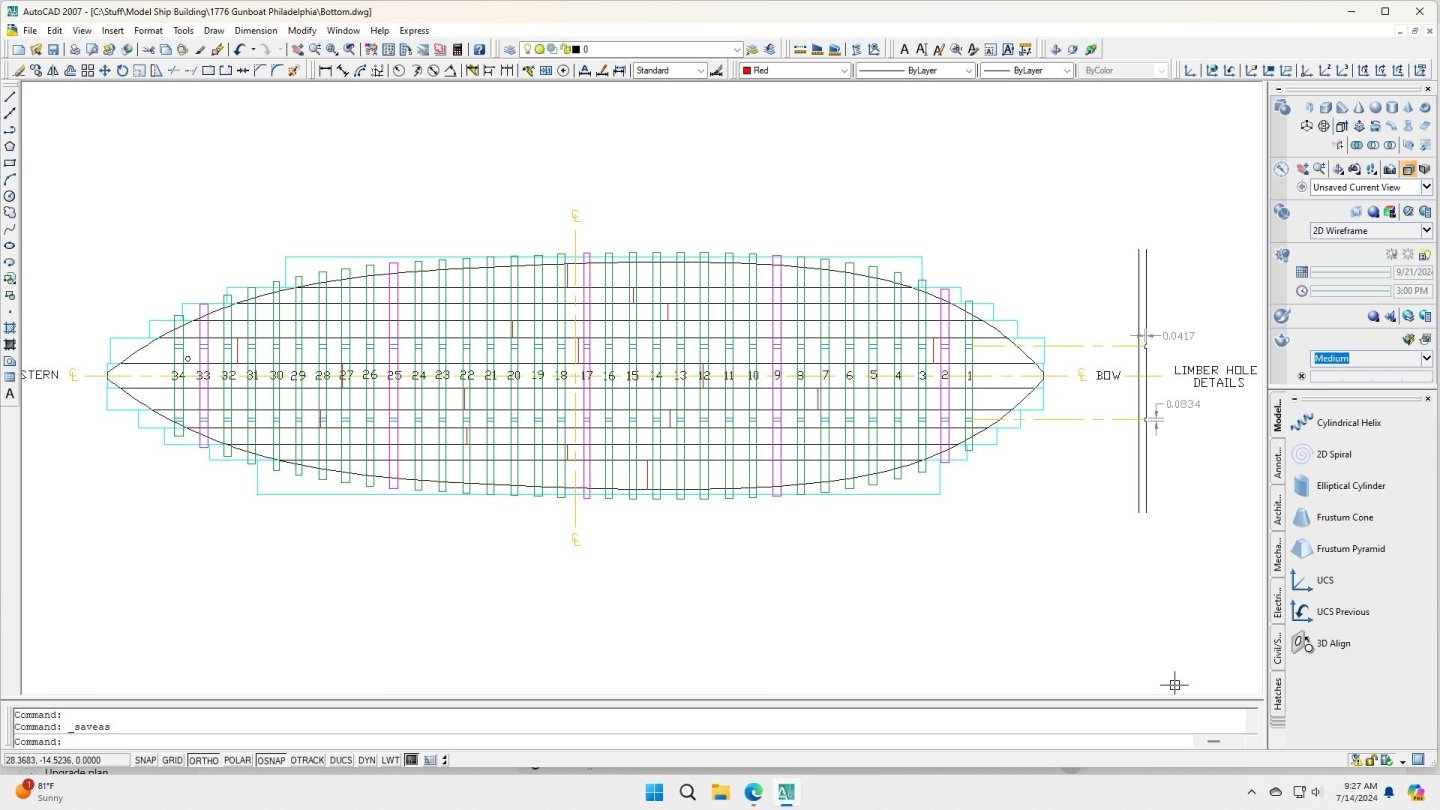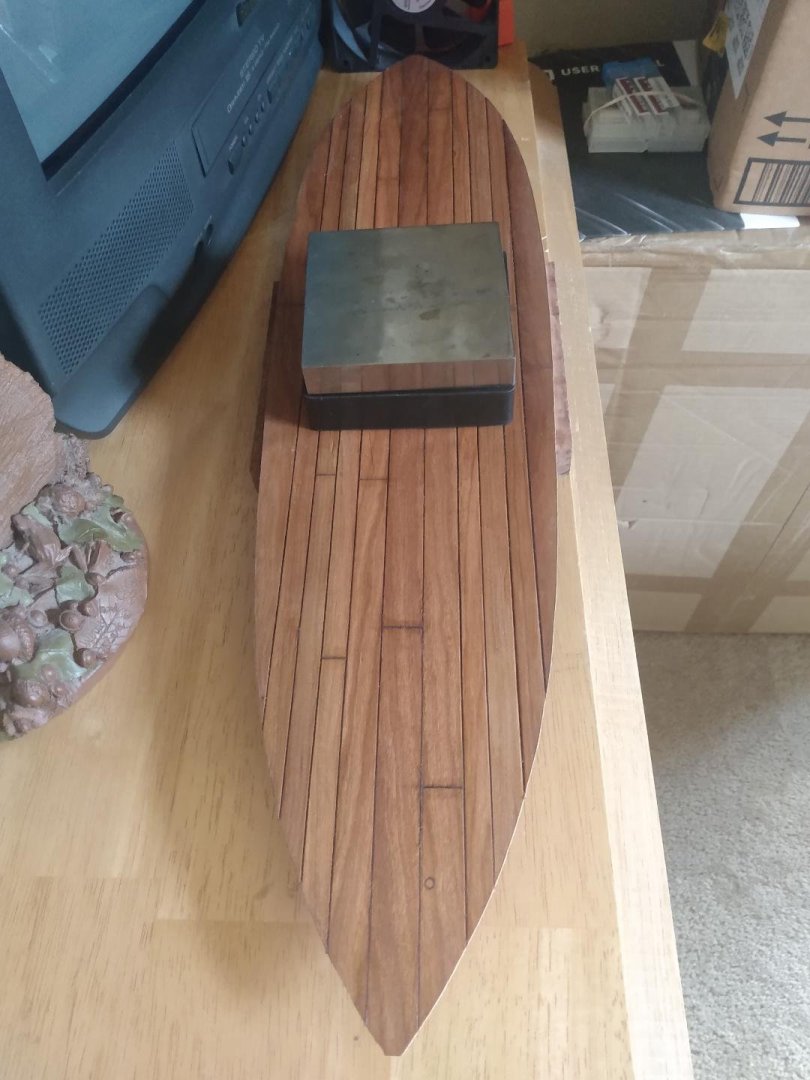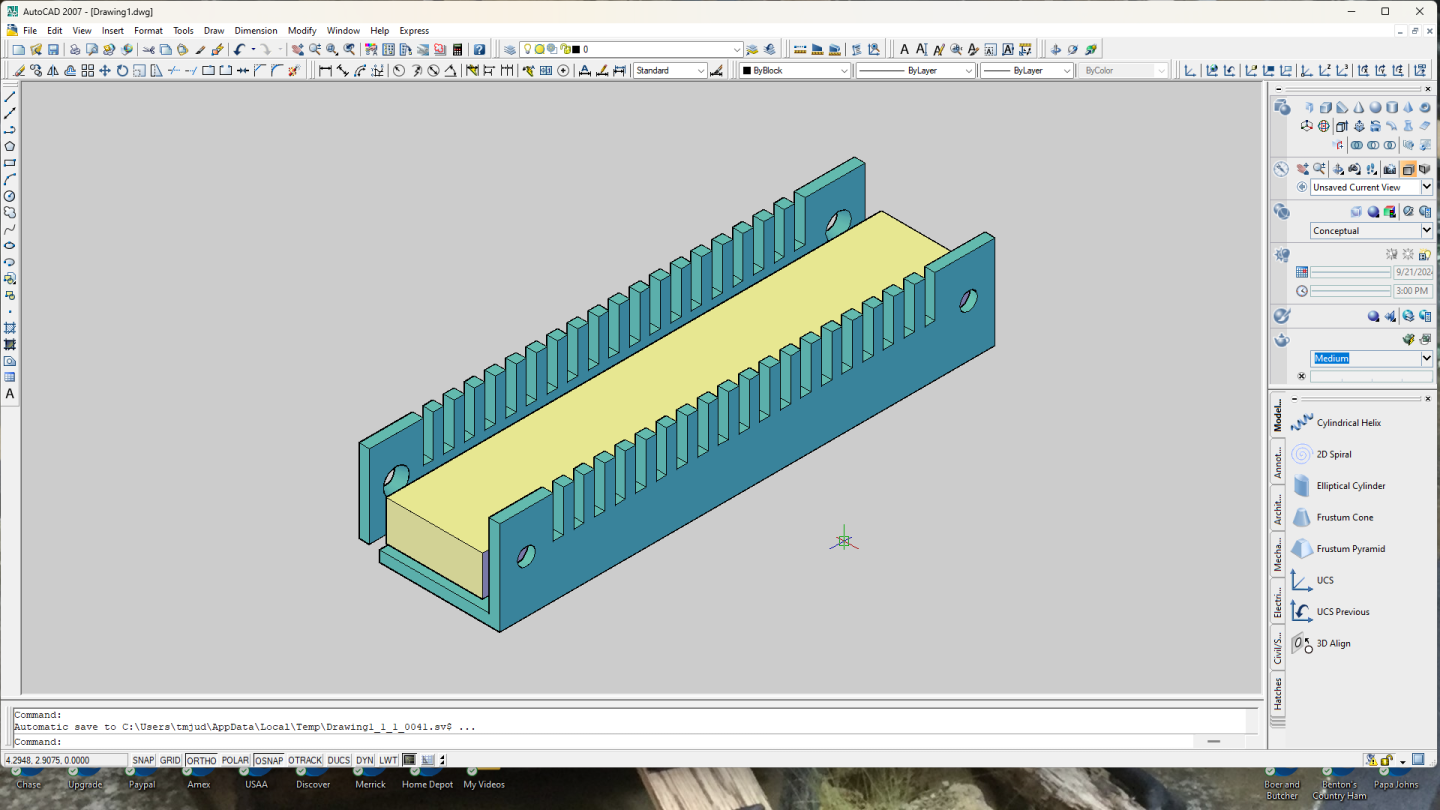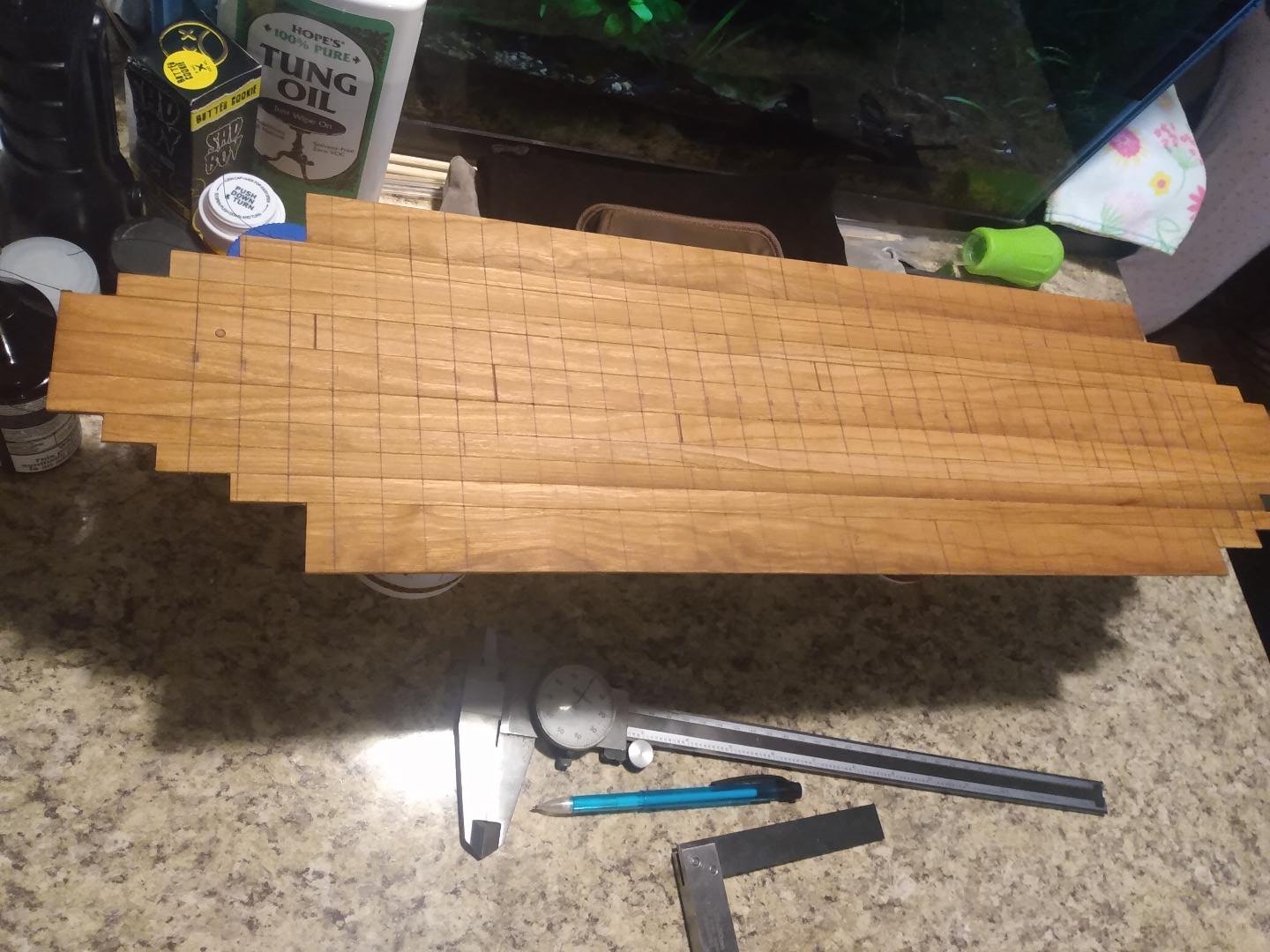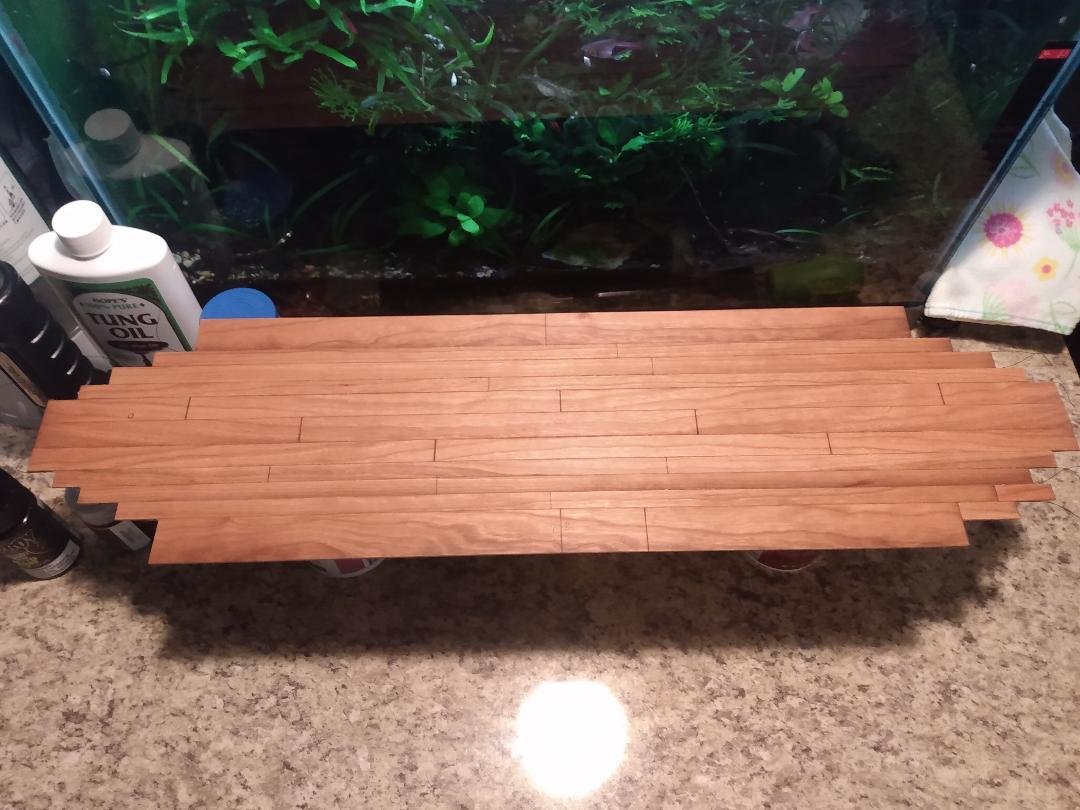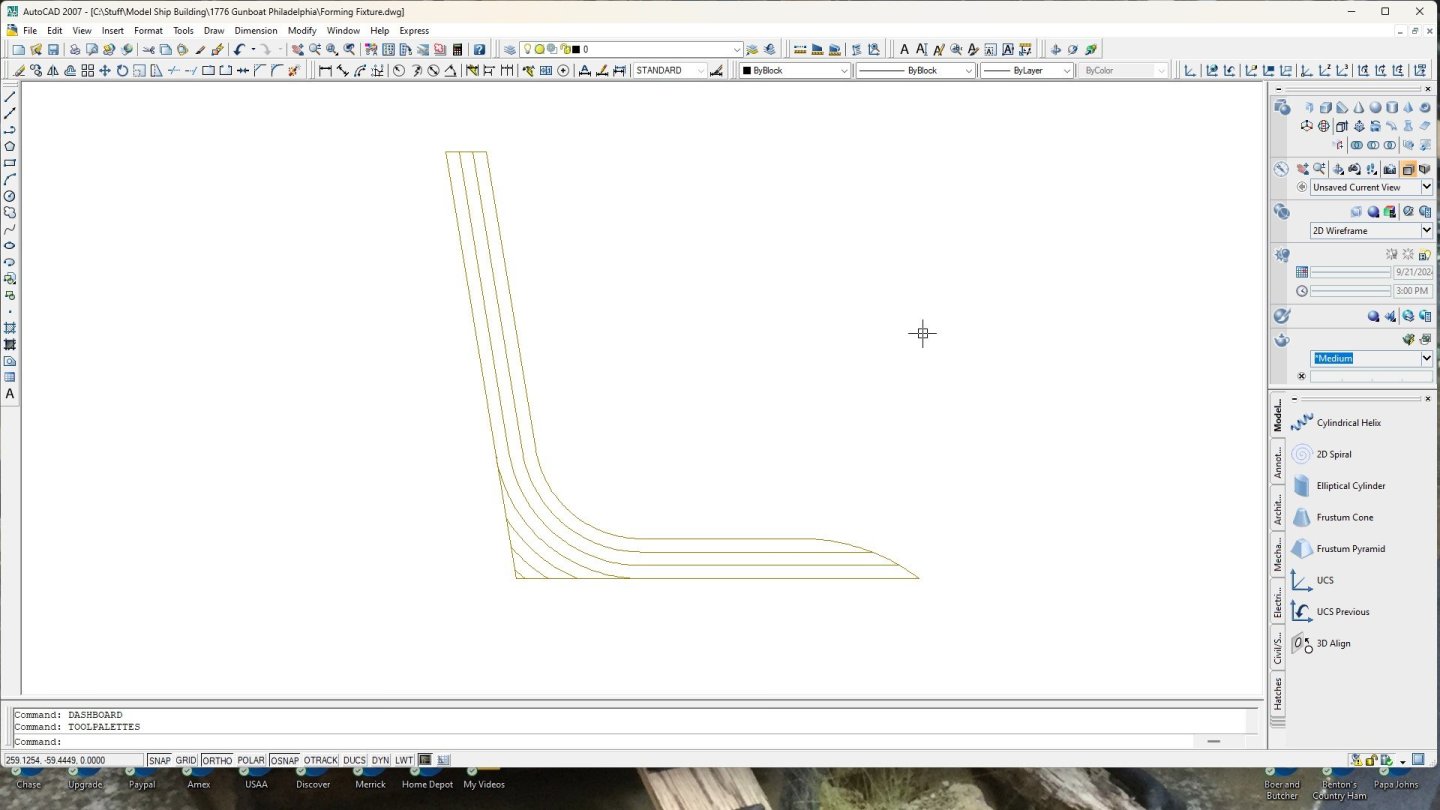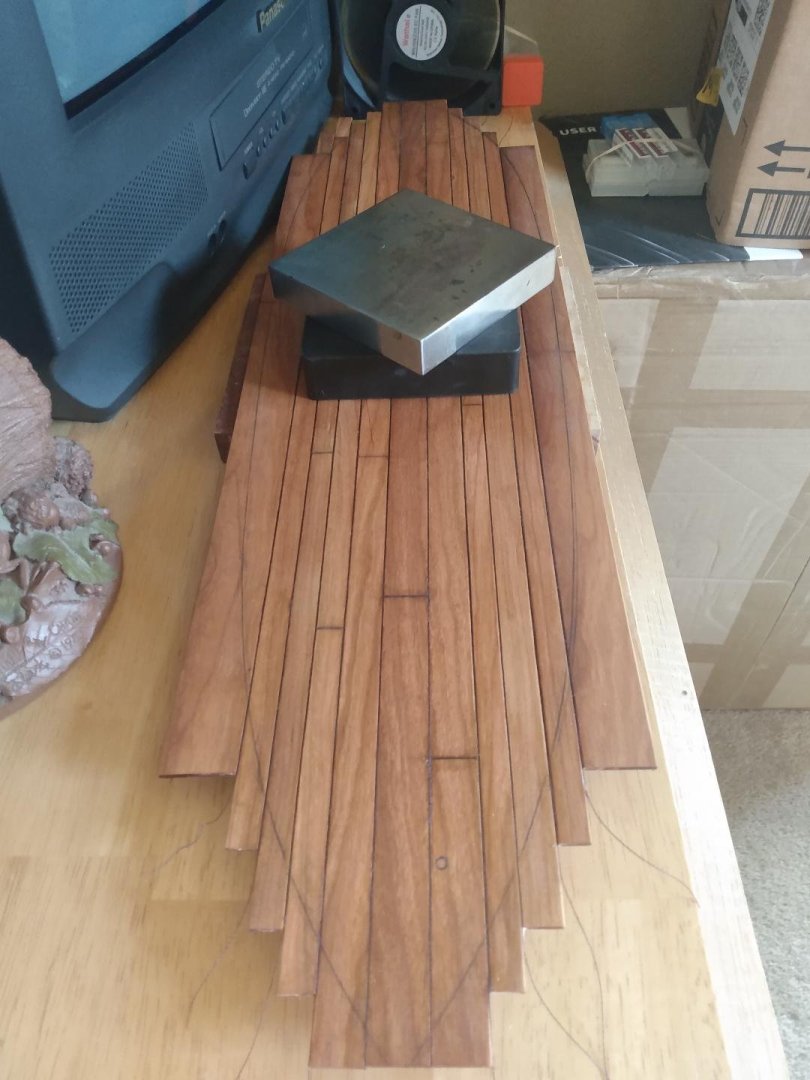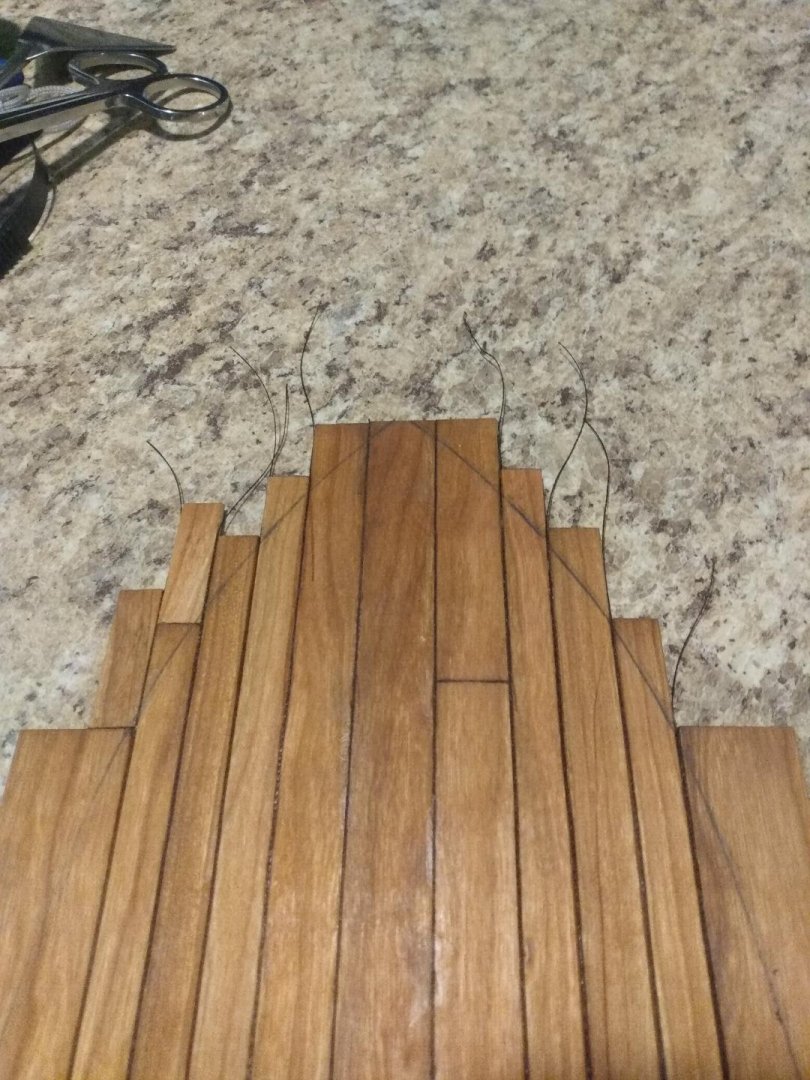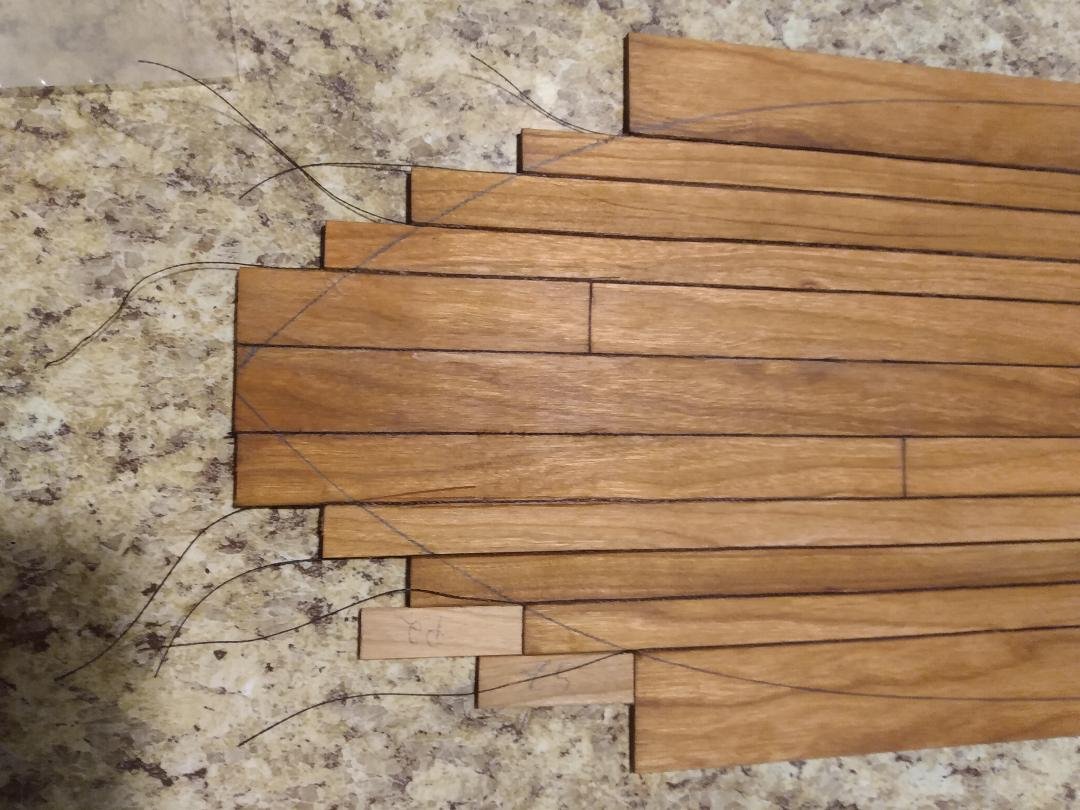-
Posts
737 -
Joined
-
Last visited
Content Type
Profiles
Forums
Gallery
Events
Everything posted by tmj
-
Hard brass is a pain, period! I hate working with the stuff unless I am forced to do so. Soft brass is soooo much easier to deal with!
-

Gunboat Philadelphia 1776 by tmj
tmj replied to tmj's topic in - Build logs for subjects built 1751 - 1800
Ribbit is not very patient. He's a "Go-Getter" who likes to take the bull by its horns and get things done! While waiting for 'me' to get my act together, he's decided to start doing a bit of QC and examine just where things currently stand. He's now checking the flatness of the bottom that he must first start with. He sees no issues and has advised me that I probably will not need to add any stainless-steel supports to my flooring timbers, albeit. He also advised me that after gluing those flooring timbers down, and also securely 'tree-nailing' those timbers to the bottom planking... things might change and there will 'still' be a chance for potential warpage. I'm heeding his advice and will incorporate the use of certain 'counter-warp' measures to ensure that such an undesirable thing does not have the opportunity to take place. -

Gunboat Philadelphia 1776 by tmj
tmj replied to tmj's topic in - Build logs for subjects built 1751 - 1800
Meet Lt. Seamus Ribbit, USN (ret). After an illustrious career 'ship-hopping' across the western Pacific, he came to me, in retirement, seeking employment. I put him to work keeping an eye on my back porch Bonsai trees and keeping the usual bugs and pests under control. When I started growing Nepenthes and Sarracenia pitcher plants, he soon found himself getting bored and also getting very hungry. My pitcher plants were taking away both his job as well as his breakfast, lunch and supper! To make things right, I have now appointed him 'Division Officer' in charge of overseeing the construction process of this vessel. He gets free room and board and I also open the front door numerous times a day to let his breakfast, lunch and dinner come inside, however. I 'am' worried about his coffee habit. A Navy 'old-timer' for sure. He reminds me of the maintenance senior chief when I was in Beeville, Tx. That maintenance chief almost always had a steaming cup of coffee in his hand, even when it was 100 degrees... and when he didn't, he usually boasted a crooked looking index finger where that coffee cup typically hung! A common Navy version of 'Carpal Tunnel Syndrome'! I'm wanting to cobble together a micro thickness sander, for small timbers, before continuing with this build... and I also needed to order some more wood. Waiting for the wood and tinkering with this thickness sander will keep me busy for the rest of the week. 'Ribbit' will be keeping an eye on things until construction resumes, hopefully this weekend. -
What Keith said. Shape of material doesn't matter. Perhaps this will also be of some help. Don't force it. If it feels like it doesn't want to bend easily anymore, stop and reheat, etc. otherwise it will crack/break.
-

Gunboat Philadelphia 1776 by tmj
tmj replied to tmj's topic in - Build logs for subjects built 1751 - 1800
These will be the first six flooring timbers installed. The timbers dimensioned in blue will be milled from 3/16" X 1/4" square stock. The timbers dimensioned in red will be milled from 3/16" X 3/16" square stock. I'll start with the 1/4" stock and mill the entire length down to dimension #1 and then cut timber #34 to length. I'll then mill what's left of the first milled piece down to the #2 dimension of timber #13 and cut 'that' timber to length, etc., etc. I'll get all four blue timbers out of one 24" length with about 3" of drop left over. I'll find use for that drop elsewhere in this build. No waste. I'll then map out another 24" worth of stock for the 3/16" X 3/16" stock before milling and cutting any of the red dimensioned timbers, to ensure maximum yield of my material. This is how the program will go until I'm down to those last 5 timbers mentioned previously. I might even 'treenail' the timbers to the bottom planking as I go, just to break up the monotony of having to make and install lots of trunnels all at the same time. I'll also need to dig out the plans again and search for another detail. It's noted that these bottom timbers were initially 'toe-nailed' to the bottom strakes of planking to simply hold things together while holes were being bored and wedge-free trunnels installed (another time saving shortcut). After the trunnels were installed, the toenails were removed. The evidence of these toenails currently exists in the real Philadelphia as it is displayed at the Smithsonian. If it is noted, on the drawings, the location of those removed toenails... I'll be adding that/those features as well. I should have looked for that when I was looking at the limber holes, but I didn't. I was too focused on one particular thing and wasn't thinking ahead. -

Gunboat Philadelphia 1776 by tmj
tmj replied to tmj's topic in - Build logs for subjects built 1751 - 1800
Flooring timbers and limber hole details have been worked out. The flooring timbers will remain long, as shown, until the frames have been installed. I'll then fair the ends of those flooring timbers to match the geometry created by the frames. The frames themselves will 'NOT' be faired. They will remain square and be placed perpendicular to the inner face of the outer planking. Not fairing the frames saved an enormous amount of time when this boat was being built. There was no time available for such a laborious task as fairing frames! Note that the limber channels are offset from the centerline of the boat. In a flat-bottomed boat, even slight inclines, as well as the natural movement of the boat can cause water to collect in various places. Offset limber holes help to ensure that water drains more efficiently towards the bilge area, or the 'bailing-well' as is the case with the Philadelphia. The five 'magenta' colored flooring timbers are the timbers that I'm going to temporarily leave out while testing the bottom for warpage. They will be installed once it is determined whether or not stiffeners will be needed. Time to get busy with the flooring timbers... -
Thanks David and Keith! It makes sense now. I had no idea that really old cannons were made up of longitudinal bars with the 'reinforces' sweated around them like a metal band around an old wooden wagon wheel. That's spooky! I imagine that it wasn't the reinforces that failed on those kinds of cannons but rather the longitudinal forge-welded seams that went kaboom! I wouldn't want to fire one of those without a very long fuse, say 50 feet or more! 😮
-
I'm curious about these reinforcement bands. Were they part of the original casting, or were those bands added 'after' the cannons were cast? I'm finding it hard to believe that they could have possibly been added as separate components, after casting, due to the complex geometries of the cannons themselves... as well as obvious blacksmithing and band welding problems. Please enlighten me as to the facts regarding the actual manufacturing process of those 18th century cannons and their curious reinforcement bands...
-

Gunboat Philadelphia 1776 by tmj
tmj replied to tmj's topic in - Build logs for subjects built 1751 - 1800
After cutting out the bottom shape, the bottom wanted to warp a bit. Not surprising. I now have it blocked up, again, and weighted down just to keep things under control until I start to install the flooring timbers that will eventually shore things up and keep the bottom flat from port to starboard. Each one of those 34 flooring timbers will have two 'limber-holes', 1" X 2" (scale = .042" X .084"), cut into them, close to the centerline, to allow for drainage of water back towards the bailing well located in the aft section of the boat. I'll be referring to the Smithsonian drawings, as well as other sources to properly locate those limber holes prior to cutting any of the flooring timbers. The current warpage of the bottom, after cutting, is very slight. I'm fairly sure that inserting stainless steel stiffeners into a few of the bottom timbers will not be necessary, albeit. We'll just have to wait and see for sure. I'm going to leave five bottom timbers out of the build, initially, for a few days. If the bottom holds its flat plane, I'll install the remaining timbers as is. If any tendency to warp shows up, I'll stuff the stainless-steel stiffeners into the middle of those five bottom timbers. Next up... bottom flooring timbers! -
Howdy Cisco! I once had an idea for making gratings without power tools but haven't yet had a need to try it. This requires a vice, an aluminum angle and an aluminum flat bar. The grating jaws would screw securely to the jaws of the vice. Different sizes of grating would require a different set of jaws. A wooden block adjusts the depth of the cut. The cuts would be made via guitar fret saws, hack saw blades, hack saw blades laminated together, whatever type of blade setup is required to produce the proper width of cuts. Just place the strips of grating wood into the fixture, atop your depth block, tighten the vice and start sawing away.
-

Gunboat Philadelphia 1776 by tmj
tmj replied to tmj's topic in - Build logs for subjects built 1751 - 1800
Yes... 'another' redundant photo of that same ol' bottom. Things should start to move along a bit faster now that Tung-Oil has cured and I can actually start doing some productive work on this thing again. I needed to lay out the bottom timber locations, prior to cutting out the shape of the bottom, while I still had true and straight edges to square off of. You might notice that that the gaps between timbers vary. My dimensions for the locations of these timbers are taken off of the Smithsonian's drawings. This is how she was actually built. All of my layed out dimensions are 'ordinate' and taken from the centerline 'zero' point to prevent any accumulation of errors to occur while laying out those 34 lines. The small 'hash-marks' located along the center strake, beside my layout lines, denote where the timbers are to actually sit with respect to the line. If done properly, there will be no visible signs of any pencil lines/marks seen anywhere atop this bottom once all of the flooring timbers are successfully installed. Next up... cutting out the shape of the bottom, 'FINALLY'! -
It funny you say that, Chuck. It just so happens that the 'Beer Drinking Guild' that I belong to recently took up model ship building!
- 80 replies
-
- rigging/masts
- NRG
-
(and 2 more)
Tagged with:
-
Hmm? Perhaps it was a 'different' Bob who messaged me, and I confused him with 'your' Bob!
-
Bob noticed that I was following this log. He sent me a message! Bob told me about your thinking he might want a job on a barge... something he said in reference to barges, but he was actually only repeating something that someone else had said to him. He didn't want to hurt your feelings, nor did he know exactly how to respond. That wooden expression was just a pause, in confusion, while mentally searching for something proper to say. He told me that for decades he had navigated familiar waters, his hands as steady as the currents that he had once mastered. Now, with retirement looming and certain 'drudgery' weighing heavy on his soul, he was feeling restless and not ready to be put on the proverbial ol' shelf, nor interested in the lackluster opportunities afforded via a mundane job on a barge. Bob told me that his mind had begun to wander back to tall tales that he had often heard from seagoing sailors. Tales of exotic ports, uncharted islands and the vast expanse of an open sea. He told me that his heart was aching for one last, 'GREAT' adventure before finally hanging it up and considering a barge. I think Bob is looking for a seagoing ship to sail upon...
-

Gunboat Philadelphia 1776 by tmj
tmj replied to tmj's topic in - Build logs for subjects built 1751 - 1800
I've applied my last beads of Tung Oil 'pitch' to the caulking seams of the bottom of this bottom, and it's curing. This view is not the bottom. I flipped it after a few hours of curing to prevent the oil from soaking too deep into the caulking grooves. I'll flip it again just before bedtime. This view is the 'top' of the bottom, the inside. I should be able to start laying out the locations of my flooring timbers on this side of the bottom this coming weekend. The two lines that you see on the outboard starboard plank are not two butt joints. One line is a centerline mark, used as a reference point for laying out the 34 flooring Timbers. The line to the right of that centerline is a butt-joint location as seen on the bottom side. These are all pencil marks, no actual seams. These marks are important as they show where the actual caulked butt-joints, from the bottom of this bottom are located. They will be covered/hidden with 'splice blocks' later on. The lines simply let me know where to place the splice blocks when it comes time to add them. I'm also working on a 'gizmo' to better replicate hewn frame members made from branching trees that will show the grain flowing in more appropriate directions for a build like this. I'm not going to show my 'concept' of this gadget right now. I might want to sell a few of these before the Chinese steal the idea and start selling cheap knockoffs. The end result would look similar to the picture below. This is not a scale image. It's only a concept meant to help me in the development of this thing. Not perfect, but better than what I've so far seen in grain orientation for most Philadelphia models and kits. I'm not knocking anyone, nor their models; I just want to add a bit more realism than what is typically seen. My frames are going to be 90% exposed. I want them to look as realistic as possible. -

Gunboat Philadelphia 1776 by tmj
tmj replied to tmj's topic in - Build logs for subjects built 1751 - 1800
Chuck, Please post a link for this five-phase plan. I'm curious and have been poking around on their site, but coming up with nothing but warnings for those who might attempt to dive that site. I can't find anything outlining their plans to raise this thing. -

Gunboat Philadelphia 1776 by tmj
tmj replied to tmj's topic in - Build logs for subjects built 1751 - 1800
The counterweights did a good job in flattening out the bottom. There are two small dips at about 4.125" and 8.125" as the rule reads, but that's okay. The oil needs another day to fully cure. I'll target those two areas with new counter-weighting measures tonight. I also checked the thickness of the wood. I'm currently about .003" too thick for proper scale. That would equate to about .072" at full scale. After final sanding, once the Tung Oil cures, I should be right about where I should be in proper scale thickness. Now it's back to the ol' curing fan for this nice-looking bottom... -

Gunboat Philadelphia 1776 by tmj
tmj replied to tmj's topic in - Build logs for subjects built 1751 - 1800
Chuck, Do you know why the Spitfire was never raised? Was it too badly decomposed, or what? -

Gunboat Philadelphia 1776 by tmj
tmj replied to tmj's topic in - Build logs for subjects built 1751 - 1800
The inside of the bottom has been sanded, Tung Oiled and is now curing in front of the fan. Nothing else to do today... waiting on Tung Oil again. I had to put weights on the bottom to counteract the bowing that occurred from Oiling the first side. This should help flatten the bottom out again. If not, I'll hide some stainless steel 'stiffeners' inside of a few of the flooring timbers to ensure that the bottom does not ever try to bow again. I might do that anyway, as an insurance policy, because there won't be enough 'side-planking' on this model to effectively hold the flat bottom 'flat' during fluctuations in humidity, the passage of time, etc. Once the Tung Oil cures, I'll lay out the locations of the flooring timbers and start cutting those timbers. -

Gunboat Philadelphia 1776 by tmj
tmj replied to tmj's topic in - Build logs for subjects built 1751 - 1800
-

Gunboat Philadelphia 1776 by tmj
tmj replied to tmj's topic in - Build logs for subjects built 1751 - 1800
That offset centerline just won't work for me. It would drive me batty! This is what I'm going to do to repair it and make things right. I think I can blend in the 'scabbed' filler pieces well enough that they won't be readily noticed. *Fingers are crossed* It's a good thing that I save small scraps and sawdust! -

Gunboat Philadelphia 1776 by tmj
tmj replied to tmj's topic in - Build logs for subjects built 1751 - 1800
Here's a flight into 'fantasy'. I dedicate this cleaver idea to Chuck Seiler for giving me this novel inspiration and a 'great' alternative solution with acceptable historic purpose via a 'pinch' of believable and sound reasoning! Should the Smithsonian ever contact me about this, "I'll deny every word of it!" In 1776, a small collection of 'gunboats' were ordered to be built. There was no time to waste! The first of these 'gunboats' was to be named 'Spitfire'. Seven other gunboats of the exact same class were to follow and be built upon Spitfires original design, however. There were problems encountered with the Spitfire's build. After all of the flooring timbers were effectively fastened to the bottom planking, it was discovered that the shape of the boats bottom hull would not properly fit within the designed parameters of the bottom strakes due to the irregular widths of the strakes themselves. The irregular widths of the strakes were not by actual design, but rather dictated by necessity via the true dimensions of the local lumber that was actually available at the time. While not of normal practice, and for the sake of immediate 'urgency', it was decided to continue with the build of Spitfire by simply offsetting the centerline of the boat from the true center of its center plank. Notes of this gross error were taken, and the remaining seven gunboats, including the Philidelphia were all more carefully laid out prior to hastily fastening the flooring timbers and cutting out the bottom shapes of their hulls. This boat was never located nor recovered for examination. You'll just have to believe Chuck and myself! 😋
About us
Modelshipworld - Advancing Ship Modeling through Research
SSL Secured
Your security is important for us so this Website is SSL-Secured
NRG Mailing Address
Nautical Research Guild
237 South Lincoln Street
Westmont IL, 60559-1917
Model Ship World ® and the MSW logo are Registered Trademarks, and belong to the Nautical Research Guild (United States Patent and Trademark Office: No. 6,929,264 & No. 6,929,274, registered Dec. 20, 2022)
Helpful Links
About the NRG
If you enjoy building ship models that are historically accurate as well as beautiful, then The Nautical Research Guild (NRG) is just right for you.
The Guild is a non-profit educational organization whose mission is to “Advance Ship Modeling Through Research”. We provide support to our members in their efforts to raise the quality of their model ships.
The Nautical Research Guild has published our world-renowned quarterly magazine, The Nautical Research Journal, since 1955. The pages of the Journal are full of articles by accomplished ship modelers who show you how they create those exquisite details on their models, and by maritime historians who show you the correct details to build. The Journal is available in both print and digital editions. Go to the NRG web site (www.thenrg.org) to download a complimentary digital copy of the Journal. The NRG also publishes plan sets, books and compilations of back issues of the Journal and the former Ships in Scale and Model Ship Builder magazines.



